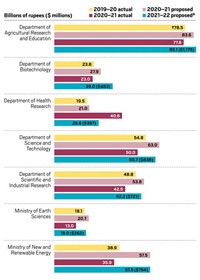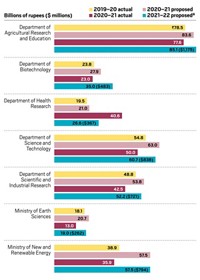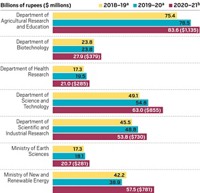Advertisement
Grab your lab coat. Let's get started
Welcome!
Welcome!
Create an account below to get 6 C&EN articles per month, receive newsletters and more - all free.
It seems this is your first time logging in online. Please enter the following information to continue.
As an ACS member you automatically get access to this site. All we need is few more details to create your reading experience.
Not you? Sign in with a different account.
Not you? Sign in with a different account.
ERROR 1
ERROR 1
ERROR 2
ERROR 2
ERROR 2
ERROR 2
ERROR 2
Password and Confirm password must match.
If you have an ACS member number, please enter it here so we can link this account to your membership. (optional)
ERROR 2
ACS values your privacy. By submitting your information, you are gaining access to C&EN and subscribing to our weekly newsletter. We use the information you provide to make your reading experience better, and we will never sell your data to third party members.
Environment
India’s science budget gets an increase
But some of the country’s scientists are disillusioned with the continuing funding trend
by K. V. Venkatasubramanian, special to C&EN
February 20, 2017
| A version of this story appeared in
Volume 95, Issue 8
India has nominally increased the allocations for science and technology (S&T), scientific research, and biotechnology in the Ministry of Science & Technology, according to its budget for 2017–18, presented on Feb. 1.
Under the proposed budget, the Department of Science & Technology (DST), India’s central agency for disbursing research grants in science, says it would receive an increase of about 8% over last year. The Department of Biotechnology, which promotes domestic technology development and transfer, reports a boost of 22%.
Expressing satisfaction about the budget, DST Secretary Ashutosh Sharma says, “The increase is sufficient to service our commitments and stabilize the rapid expansion of the last two years.”
Proposed science spending
Note: Figures were converted from Indian rupees to U.S. dollars at the Feb. 6 exchange rate of $1.00 U.S. = 67.22 rupees. Because of currency fluctuations, percent increases calculated from these data may not match those given by ministry or department officials. a Actual. b Proposed.
Source: Indian Ministry of Finance (indiabudget.nic.in/vol2.asp)

Note: Figures were converted from Indian rupees to U.S. dollars at the Feb. 6 exchange rate of $1.00 U.S. = 67.22 rupees. Because of currency fluctuations, percent increases calculated from these data may not match those given by ministry or department officials. a Actual. b Proposed.
Source: Indian Ministry of Finance (indiabudget.nic.in/vol2.asp)
DST plans to develop several new, large-scale programs next year on inclusion and gender equality in science; science communication; technologies for a sustainable environment; and systems that integrate computation, networking, and physical processes.
“We will work on raising further resources later this year once we are ready to launch these programs,” Sharma says.
DST’s budget increased significantly during the past two years (2015–16 and 2016–17) compared with funding in 2014–15. Sharma says, “This allowed substantial strengthening of our existing S&T ecosystem together with initiating several new and ambitious programs in supercomputing, big data, sensors, advanced manufacturing, waste processing, the Laser Interferometer Gravitational Wave Observatory (LIGO), micro-industries for rural India, clean energy and materials, technology business incubators and start-ups, as well as in seeding the percepts of innovation in 500,000 schools across the nation.”
Krishnaswamy VijayRaghavan, secretary of the Department of Biotechnology, says that department will launch new programs in biopharma, agriculture, clean energy, epidemic preparedness, and marine biology. Most of them are interministerial—they involve more than one government entity—and in some cases have international partnerships. These programs are expected to begin during 2017–18.
Some scientists in India, however, say the funding is insufficient. The science R&D budget, excluding space, nuclear energy, and major long-term programs, “is not increasing proportionately anywhere near the number of scientists that we have added to the nation’s pool,” says Krishna Ganesh, a chemistry professor and director of the Indian Institute of Science Education & Research, Pune.
At the annual session of the Indian Science Congress in January, Prime Minister Narendra Modi announced a goal for India to become a major global power in driving science by 2022.
“Such announcements constantly give hope to scientists about possible increased allocation to S&T sectors,” Ganesh says. “However, every year, scientists get disillusioned as we get to know the actual distributions. This year follows the same trend of the past but with more disillusionment.”
The top technological institutions, such as the Indian Institutes of Technology, have received a big boost in the Ministry of Human Resources Development budget, reporting an increase of about 50% compared with 2016–17. There is negligible enhancement for science at the Indian Institutes of Science, Education & Research; Central Universities; and the Indian Institute of Science, he observes.
Ganesh says the situation is “distressing for scientists” in India. He notes that Indian scientists’ per-capita expenses are low when compared with those of their colleagues globally. Despite this, the output of Indian scientists compares well with that of scientists in the rest of the world, he says.
During the past decade, India has established a host of central universities and technology and research institutes that have added close to 1,000 young scientists, mostly from abroad. “This has opened up opportunity for India to join developed countries in advanced basic sciences and research,” Ganesh says.
K. V. Venkatasubramanian is a freelance journalist in Delhi.





Join the conversation
Contact the reporter
Submit a Letter to the Editor for publication
Engage with us on Twitter